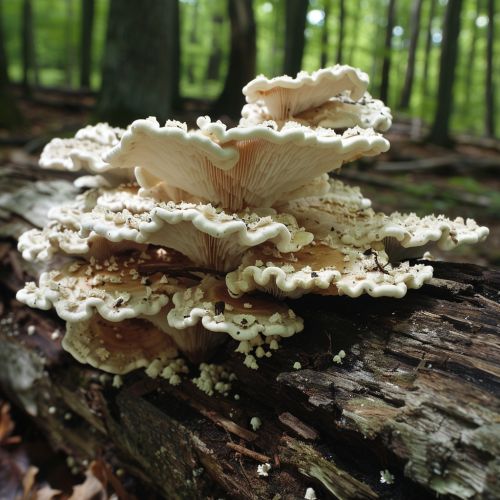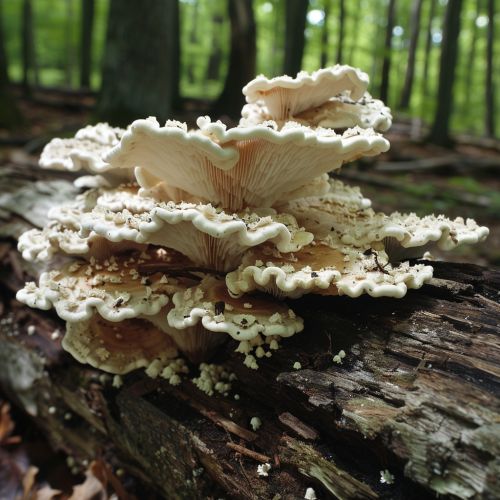White rot fungi
Introduction
White rot fungi are a diverse group of fungi that are capable of degrading lignin, a complex aromatic polymer found in the cell walls of plants. This unique ability distinguishes them from other types of fungi, such as brown rot fungi and soft rot fungi, which primarily degrade cellulose and hemicellulose. White rot fungi play a crucial role in the carbon cycle by breaking down lignin and other complex organic compounds, thereby contributing to the decomposition of plant material and the recycling of nutrients in ecosystems.
Taxonomy and Classification
White rot fungi belong to the phylum Basidiomycota, which includes many well-known fungi such as mushrooms, puffballs, and shelf fungi. Within this phylum, white rot fungi are primarily found in the orders Polyporales, Agaricales, and Russulales. Some of the most studied genera of white rot fungi include Phanerochaete, Trametes, Pleurotus, and Ganoderma.
Mechanism of Lignin Degradation
The ability of white rot fungi to degrade lignin is attributed to their production of extracellular oxidative enzymes. The primary enzymes involved in lignin degradation are lignin peroxidases (LiPs), manganese peroxidases (MnPs), and laccases. These enzymes work synergistically to break down the complex structure of lignin into smaller, more manageable molecules.
Lignin Peroxidases (LiPs)
Lignin peroxidases are heme-containing enzymes that catalyze the oxidation of lignin by hydrogen peroxide. They are capable of cleaving the carbon-carbon and carbon-oxygen bonds in lignin, leading to the formation of smaller aromatic compounds.
Manganese Peroxidases (MnPs)
Manganese peroxidases oxidize Mn(II) to Mn(III), which then acts as a diffusible oxidizer that can degrade lignin and other phenolic compounds. MnPs are particularly important in the degradation of non-phenolic lignin structures.
Laccases
Laccases are copper-containing oxidases that catalyze the oxidation of phenolic substrates by molecular oxygen. They play a significant role in the initial stages of lignin degradation and in the detoxification of lignin-derived compounds.


Ecological Significance
White rot fungi are found in a variety of habitats, including forests, grasslands, and wetlands. They are particularly abundant in temperate and tropical forests, where they play a key role in the decomposition of woody plant material. By breaking down lignin, white rot fungi facilitate the recycling of carbon and other nutrients, thereby maintaining the health and productivity of ecosystems.
Applications in Biotechnology
The unique enzymatic capabilities of white rot fungi have garnered significant interest in various biotechnological applications. Some of the most promising applications include:
Bioremediation
White rot fungi have been explored for their potential in bioremediation, the process of using biological organisms to remove or neutralize contaminants from the environment. Their lignin-degrading enzymes can break down a wide range of environmental pollutants, including polycyclic aromatic hydrocarbons (PAHs), polychlorinated biphenyls (PCBs), and synthetic dyes.
Pulp and Paper Industry
In the pulp and paper industry, white rot fungi are used in biopulping and biobleaching processes. Biopulping involves the use of fungal enzymes to partially degrade lignin in wood chips before mechanical or chemical pulping, thereby reducing the energy and chemical requirements of the process. Biobleaching uses fungal enzymes to bleach pulp, reducing the need for harmful chlorine-based chemicals.
Biofuel Production
White rot fungi are also being investigated for their potential in biofuel production. By breaking down lignocellulosic biomass into fermentable sugars, they can enhance the efficiency of bioethanol production. The use of fungal enzymes in the pretreatment of biomass can improve the overall yield and reduce the cost of biofuel production.
Challenges and Future Directions
Despite their potential, the application of white rot fungi in industrial processes faces several challenges. One of the main challenges is the optimization of enzyme production and activity under industrial conditions. Additionally, the genetic manipulation of white rot fungi is still in its early stages, and more research is needed to fully harness their capabilities.
Future research is likely to focus on the discovery and characterization of new lignin-degrading enzymes, the development of more efficient fungal strains through genetic engineering, and the integration of fungal enzymes into existing industrial processes. Advances in these areas could significantly enhance the sustainability and efficiency of various biotechnological applications.
